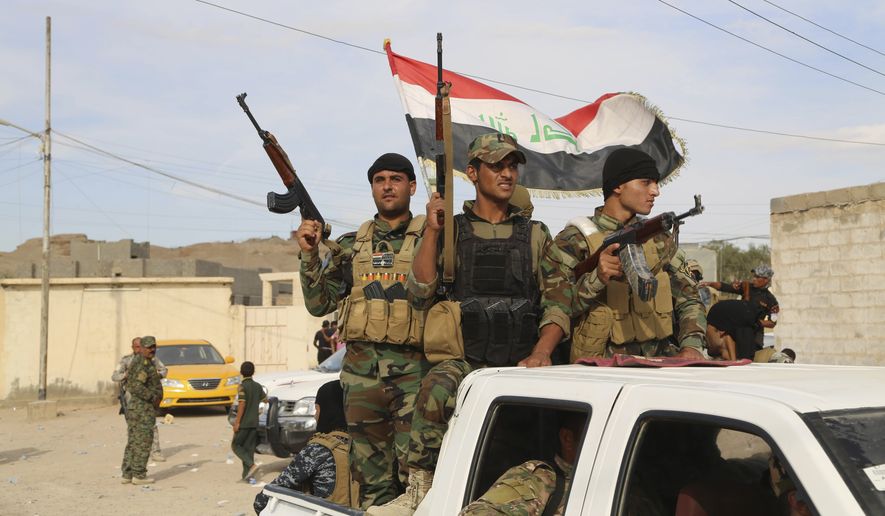The Obama administration admits its push for a “Sunni Awakening 2.0” to break the Islamic State’s grip on Iraq’s western Anbar province has gone more slowly than hoped, but officials say they’re not giving up on the effort.
Critics say the strategy so far hasn’t come close to replicating the success of the first awakening, which roughly coincided with President George W. Bush’s “surge” in early 2007. Under President Obama, there were no U.S. combat troops bolstering the current drive, while many tribal leaders key to the first awakening were assassinated when the American forces left Iraq between 2008 and 2011.
“It has been a very slow and painful process, and everybody would like to see this move more quickly,” one U.S. official involved in the current effort acknowledged Tuesday. “But we’re also realistic about it — we knew this was going to be a multiyear campaign when we started it.”
U.S. officials say the Anbar campaign is more focused on trying to establish a long-term Sunni tribal force that is paid by the Iraqi government and can hold territory once it is finally seized back from the extremists.
But there is no clear indication of when that might be, leaving some to wonder whether the overall “Awakening 2.0” strategy has fallen so flat over the past year that the administration has effectively abandoned it.
While the Pentagon claims “thousands” of Sunni tribal fighters have come online and are now operating in concert with Iraqi government security forces, the goal of luring Anbar’s sheiks into a new “awakening” may well have been doomed from the start.
The Islamic State “surgically killed nearly all of the awakening’s key leaders,” said Craig Whiteside, a former U.S. Army officer who worked with tribes in Anbar during the mid-2000s and now teaches at the U.S. Naval War College in Monterey, California.
Operatives from the Islamic State in Iraq, also known as ISIS and ISIL, “collected intelligence on the tribes in Anbar, figured out who was holding the awakening together and then murdered them,” Mr. Whiteside said in an interview.
Mr. Whiteside said his research found that Islamic State operatives killed some 1,345 awakening members and leaders between 2009 and 2014.
“I’m guessing we figured out pretty quickly that the Islamic State had been taking steady measures since 2008 to inoculate against this ’redo the awakening’ strategy,” he said. “In a perfect world, the Sunnis would probably say, ’Yes, we’d rather work with the Americans and reconcile with the Iraqi government than be aligned with ISIS,’ but they can’t because the Islamic State has established control not only over their areas but also over their families.”
The first awakening, he added, happened at a time when thousands of American troops were in Anbar and U.S. jets were providing heavy air support to back up the Sunni tribal fighters on the ground.
Banking on Baghdad
Today the Obama administration’s strategy is far more dependent upon the Iraqi government and its security forces to take the lead in bringing the Sunni tribal into the fold against Islamic State.
Army Col. Steve Warren, a Pentagon spokesman based in Baghdad, told The Times this week that “the Iraqi government is paying and training the tribal fighters.”
While he said “U.S. forces provide advice and oversight there is no direct contact with U.S. forces during subject matter exchanges with tribal forces.”
The training that does occur typically lasts for 10 days and takes place at the Al Asad and Taqaddum air bases in Anbar province as well as Camp Taji roughly 20 miles north of Baghdad.
Col. Warren said there are “over 1,000 Sunni tribal fighters” involved in Iraqi military-led operations around the Islamic State-held city of Ramadi, Anbar’s capital and long a hub for Sunni tribal leaders.
Another roughly 1,110 tribal fighters are engaged in operations closer to Baghdad. “The government of Iraq has armed many of these tribal forces with weapons from [Iraqi Security Forces], as well as a few select groups with U.S.-provided weapons,” Col. Warren said.
A total of 7,000 Sunni tribesmen have actually enrolled, with about 3,500 having so far been trained, according to the official who spoke anonymously with The Times on Tuesday.
The official also denied that the overall effort has been crippled because so many members and leaders of the first awakening had been assassinated.
“Their sons have stepped up and they have a vendetta against [Islamic State] because their fathers were killed,” the official said. “Some have been forced into submission, yes, but for many it’s doubled their resolve.”
Still, there are big questions looming about whether the anti-Islamic State forces can grow.
A key part of the Obama administration’s approach thus far has been to pressure the Shiite-dominated government of Iraqi Prime Minister Haider al-Abadi to create a new “national guard force” under which the Sunnis and other militias would be given formal status and have their pay guaranteed by Baghdad.
But the legislation for such a force has been stalled in Iraq’s parliament for months, and some contend Mr. al-Abadi is unable to push it through amid resistance from Iran-backed players on the political scene who don’t want to see the Sunnis gain any more legitimacy.
Lahur Talabani, a top Kurdish intelligence official, told an audience in Washington last week that certain Shiite groups in Iraq have become so aligned with the Iran’s military that they are simply “against the reforms of Abadi.”
“They see Abadi as pro-West and pro-American, and so they are trying to bring him down,” said Mr. Talabani, head of the Kurdistan Regional Government’s intelligence service. “Somehow the Sunnis also need to be brought back into the political process. They need to be part of this. They are really divided right now, and they don’t have that key figure who could unite [them].”
• Guy Taylor can be reached at gtaylor@washingtontimes.com.




Please read our comment policy before commenting.